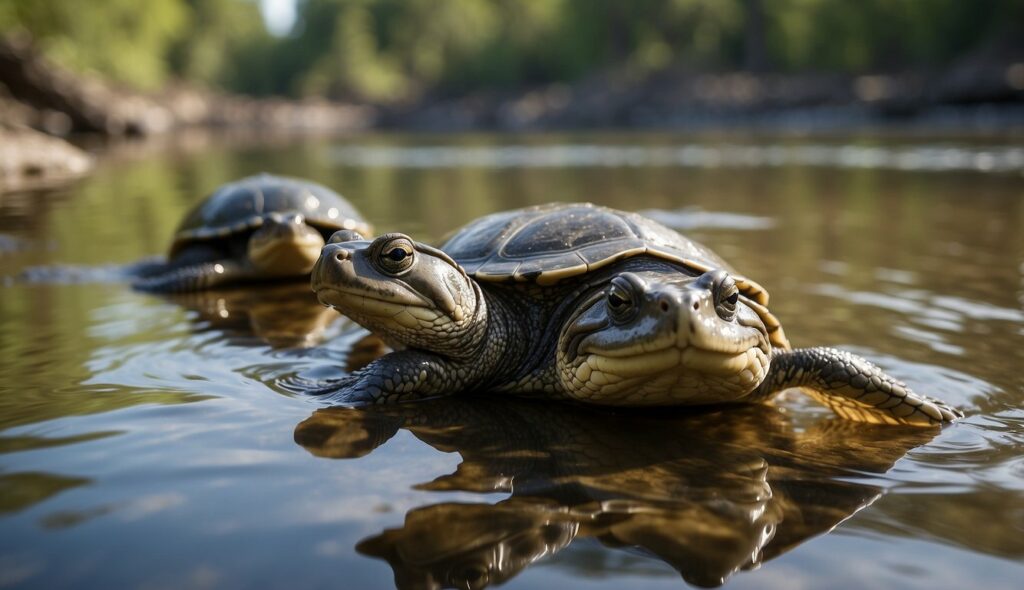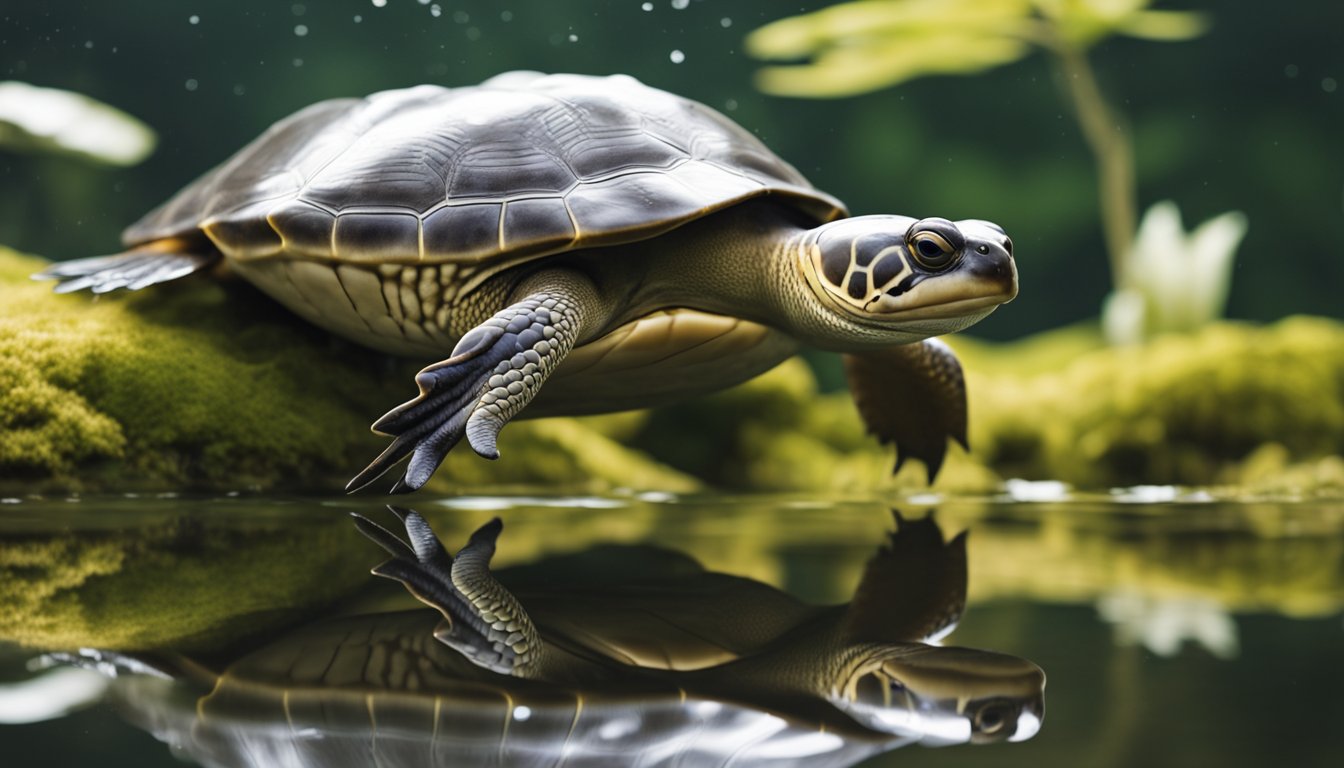Softshell turtles are fascinating creatures that stand out in the bustling underwater realm.
With pancake-flat bodies and snorkel-like noses, they appear almost alien among their hard-shelled relatives.
These turtles have traded the typical armor for a leathery carapace that allows them to glide through the water with remarkable speed and agility.
Imagine a swimmer wearing a sleek wetsuit versus an old-fashioned, bulky diving suit – that’s the kind of advantage softshell turtles enjoy.

While other turtles might seem to lumber through their aquatic habitats, softshell turtles slice through the currents.
Their flexible shells, which feel like rubber to the touch, help them disappear into the sandy bottoms of rivers and lakes, becoming one with the terrain.
They’re adept hunters, snatching fish and crustaceans with a speed that seems almost unfair. What’s their secret?
It’s all in their unique design; flat, streamlined, and built for the chase.
As they bask on sunny riverbanks, it’s difficult to believe these serene animals are the same swift swimmers you see in the water.
Have you ever watched leaves flutter in a breeze or a kite soar in the wind?
That’s how effortlessly softshell turtles seem to navigate their watery world.
They teach us that the animal kingdom is full of surprises – a place where the phrase “fitting in” takes on a whole new meaning.
What Are Softshell Turtles?
Imagine swimming alongside a creature with a pancake-flat body, a long neck, and a snorkel-like nose.
That’s a softshell turtle for you!
They’re one of the most distinct and fascinating swimmers in rivers and lakes across the world.
Physical Characteristics Of Softshell Turtles?
Softshell turtles are easily distinguished by their smooth, leathery shells, which lack the hard, scaly segments known as scutes that are typical of other turtles.
This flexible shell allows them to move quickly in water and burrow into sand with ease.
Their nostrils, located at the end of a long, tube-shaped snout, act like snorkels, enabling them to breathe while mostly submerged.
These turtles also have webbed feet, perfect paddles for their aquatic lifestyle.
Habitat and Distribution
Softshell turtles are found in a variety of water bodies, from rivers to lakes, and even brackish environments.
They prefer a soft bed, where they can bury themselves and ambush their prey.
These unique turtles are widespread and inhabit areas in Africa, Asia, and North America.
Their presence in different continents highlights their adaptability and the various ecological niches they successfully occupy.
While you won’t see softshell turtles at every water’s edge, their distinctive characteristics make them an unforgettable sight if you do spot one gliding through the water or basking on a sunny riverbank.
They remain a symbol of nature’s creativity—equipped not only to survive but also to thrive in their watery realms.
The Biology of Softshell Turtles

Diet and Hunting Techniques
Softshell turtles are carnivorous, with their diet primarily consisting of fish, insects, and crustaceans.
They employ a sit-and-wait strategy, burying themselves in the substrate and pouncing on unsuspecting prey with their long, flexible necks.
They have elongated snouts which function like snorkels, allowing them to breathe while remaining submerged and hidden.
This adaptation gives them an edge in the aquatic environments they inhabit.
Reproduction and Life Cycle
Reproduction in softshell turtles involves distinctive nesting behaviors.
Females lay eggs in sandy or muddy banks, selecting sites with ample sunlight to ensure proper incubation.
After laying eggs, females leave the nest site, and the young are left to fend for themselves.
Hatchlings emerge after about two months, fully independent and equipped with the innate ability to swim and hunt.
Softshell turtles can live for several decades in the wild, with their lifespans influenced by ecological factors and predation.
Threats and Conservation

Softshell turtles are fascinating creatures, but they are facing some serious challenges.
As with many animals, their existence is being threatened by activities of people and changes in their natural habitats.
They need our help, and conservation efforts are underway to protect these unique swimmers for future generations.
Human Impact On Softshell Turtles
Softshell turtles have encountered several threats directly linked to human activities.
They are often victims of habitat destruction caused by construction, pollution, and the draining of wetlands for agriculture.
Water pollution is particularly harmful to these turtles, as they rely on clean water for hunting and reproduction.
Along with habitat issues, softshell turtles are also hunted for their meat and eggs.
Their leathery shells are used in traditional medicine and sold in the pet trade, which increases pressure on their populations.
In some areas, they often perish as bycatch, accidentally caught in fishing gear intended for other species.
Conservation Efforts
Conservation efforts are crucial to safeguard softshell turtles from slipping away.
These initiatives include habitat protection, establishing breeding programs, and enforcing laws that restrict hunting and trade of these animals.
Protected areas have been set up in parts of the world to preserve their natural environments.
Environmental organizations are working to clean up bodies of water, while legislation aims to lessen the negative effects of pollution and construction on aquatic habitats.
Educational programs raise awareness about the turtles’ plight and encourage locals to participate in their protection.
Through collaborative actions by governments, conservationists, and local communities, there is hope that the softshell turtles can continue gliding through the world’s waters for years to come.
Frequently Asked Questions About Softshell Turtles

What makes softshell turtles stand out in the animal kingdom?
Softshell turtles are distinguished by their distinctive leathery shells, which are unlike the hard shells of most other turtles.
Their flexible shells allow them to move with more agility in the water.
They are also equipped with elongated snouts that enable them to breathe while mostly submerged, enhancing their ability to surprise prey or avoid predators.
Is it safe for humans to interact with softshell turtles?
While softshell turtles may look harmless, they can be quite defensive if they feel threatened. They have sharp jaws that can deliver a strong bite.
Therefore, it’s best for humans to admire them from a distance in their natural habitats or in settings where they are cared for by professionals who understand their needs and behaviors.
What are the differences between a softshell turtle’s shell and other turtles’ shells?
The main difference is that a softshell turtle’s shell lacks the hard, bony plates, or scutes, found on other turtles.
Instead, their carapace is covered by a tough, rubbery skin that’s more flexible.
This unique adaptation helps them in quick, graceful swimming and burying themselves in sandy riverbeds for camouflage.
What threats are faced by softshell turtles in their natural habitat?
Their habitats are often at risk due to pollution, waterway development, and overfishing, which can lead to a decline in softshell turtle numbers.
Additionally, they are sometimes captured for the pet trade or hunted for their meat, leading to further pressure on their populations.
How large can spiny softshell turtles grow?
Spiny softshell turtles, a subset of softshell turtles, can reach impressive sizes.
Females typically grow larger than males, with some reaching up to 19 inches (48 cm) in shell length.
Their size helps deter many predators and gives them a commanding presence in their aquatic environments.
Can you tell me some astonishing facts about softshell turtles?
Did you know softshell turtles can stay submerged for up to five hours by absorbing oxygen through their skin? It’s true!
Moreover, despite their bulky appearance, they can sprint on land surprisingly fast to evade danger.
They’re also quite ancient, with ancestors dating back to the Cretaceous period—talk about a living fossil swimming in our rivers and lakes!









